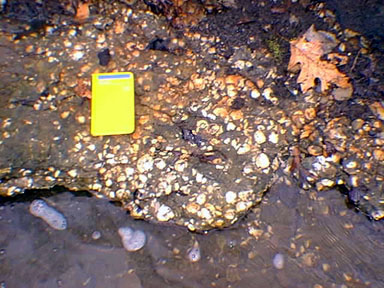55. Crosswicks Creek
The Early Paleocene Hornerstown Formation crops out along the streams and lower hillsides along Crosswicks Creek east of New Egypt, New Jersey. In the past this area was intensely studied for its paleontological resources. Fossils are generally scarce in this dark green glauconitic sand formation with the exception of rare molds and casts of gastropods, pelecypods, and bone material. The overlying Paleocene Vincentown Formation crops out on the hillsides and along tributaries of Crosswicks Creek. The Vincentown is recognizable by an abundance of the brachiopod, Oleneothyris harlani, and an occasional oyster, Gryphaea dissimilaris; other fossils are scarce (Figure 132, and see descriptions of the Vincentown and Hornerstown formations on the Tertiary Stratigraphy page). These fossils occur in massive pod-like lenses with individual shells embedded chaotically in a glauconitic marl matrix. The occurrence of such a great abundance of brachiopods is very unusual after the close of the Paleozoic. The general lack of other types of fossils suggests that the brachiopods were either well-adapted to a specific range of conditions in a shallow marine setting, or possibly, they had very little competition from other species following the mass extinction at the end of the Cretaceous.
 |
| Figure 132. An Oleneothyrus shell bed in the Vincentown Formation near New Egypt, New Jersey. |
The state has recently made parking and public access to the stream for fishing and canoeing. A parking area is located on Route 539 just south of the intersection with Route 537 near Hornerstown (just east of New Egypt, New Jersey). From this location it is possible to walk or wade downstream to examine cut banks along the stream and along side creeks; there is no trail, and conditions can be downright miserable during mosquito season. Like all major streams in New Jersey, the main channel is accessible to the public, but cut banks along the side of the stream may be private land. If signs are posted, then the banks are off limits without the land owners permission. Fossils can occasionally be found on gravel deposits when stream levels are low. Be aware that Crosswicks Creek is extremely hazardous during high water, which means practically any time of year, but particularly in the late winter to late spring.
| Return to Geology of the Coastal Plain Province. |